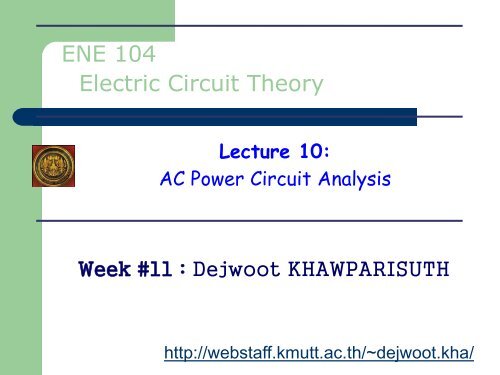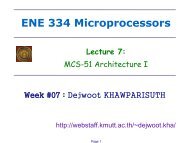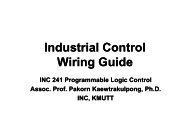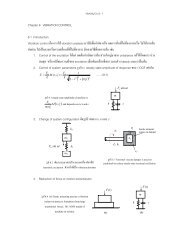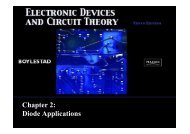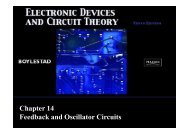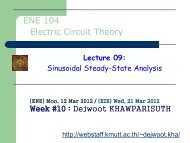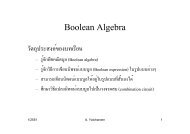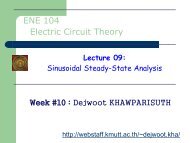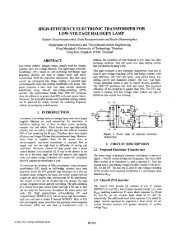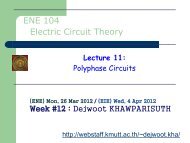ENE 104 Electric Circuit Theory - staff.kmutt.ac.th - kmutt
ENE 104 Electric Circuit Theory - staff.kmutt.ac.th - kmutt
ENE 104 Electric Circuit Theory - staff.kmutt.ac.th - kmutt
- No tags were found...
Create successful ePaper yourself
Turn your PDF publications into a flip-book with our unique Google optimized e-Paper software.
<strong>ENE</strong> <strong>104</strong><br />
<strong>Electric</strong> <strong>Circuit</strong> <strong>Theory</strong><br />
Lecture 10:<br />
AC Power <strong>Circuit</strong> Analysis<br />
Week #11 : Dejwoot KHAWPARISUTH<br />
http://web<strong>staff</strong>.<strong>kmutt</strong>.<strong>ac</strong>.<strong>th</strong>/~dejwoot.kha/
<strong>ENE</strong> <strong>104</strong><br />
Objectives : Ch11<br />
AC <strong>Circuit</strong> Power Analysis<br />
Page 2<br />
Week #11<br />
• <strong>th</strong>e instantaneous power<br />
• <strong>th</strong>e average power<br />
• <strong>th</strong>e rms value of a time-varying waveform<br />
• complex power: average and re<strong>ac</strong>tive power<br />
• <strong>th</strong>e power f<strong>ac</strong>tor, how to improve.
<strong>ENE</strong> <strong>104</strong><br />
AC <strong>Circuit</strong> Power Analysis<br />
Week #11<br />
Instantaneous Power:<br />
p t = v t i(t)<br />
Page 3<br />
<strong>th</strong>e device is a resistor:<br />
p t = i 2 t R = v2 t<br />
R<br />
<strong>th</strong>e device is entirely inductive:<br />
p t = Li t<br />
di t<br />
dt<br />
= 1 v(t) t<br />
v t ′ d<br />
L −∞<br />
t ′<br />
<strong>th</strong>e device is entirely cap<strong>ac</strong>itive:<br />
p t = Cv t<br />
dv t<br />
dt<br />
= 1 i(t) t<br />
i t ′ d<br />
C −∞<br />
t ′
<strong>ENE</strong> <strong>104</strong><br />
Instantaneous Power:<br />
AC <strong>Circuit</strong> Power Analysis<br />
Page 4<br />
Week #11<br />
Consider <strong>th</strong>e series RL circuit,<br />
i t = V 0<br />
R<br />
1 − e−Rt L u(t)<br />
The total power delivered by <strong>th</strong>e source<br />
p t = v t i t = V 0 2<br />
R<br />
1 − e−Rt L u(t)
<strong>ENE</strong> <strong>104</strong><br />
Instantaneous Power:<br />
AC <strong>Circuit</strong> Power Analysis<br />
Page 5<br />
Week #11<br />
Consider <strong>th</strong>e series RL circuit,<br />
i t = V 0<br />
R<br />
1 − e−Rt L u(t)<br />
The power delivered to <strong>th</strong>e resistor is<br />
p R t = i 2 t R = V 0 2<br />
R (1 − e−Rt L ) 2 u(t)
<strong>ENE</strong> <strong>104</strong><br />
Instantaneous Power:<br />
AC <strong>Circuit</strong> Power Analysis<br />
Page 6<br />
Week #11<br />
Consider <strong>th</strong>e series RL circuit,<br />
i t = V 0<br />
R<br />
1 − e−Rt L u(t)<br />
to determine <strong>th</strong>e power absorbed by <strong>th</strong>e inductor, first<br />
Then,<br />
v L (t) = L di(t)<br />
dt<br />
= V 0 e −Rt L u t + LV 0<br />
R<br />
= V 0 e −Rt L u t<br />
p L (t) = v L t i(t) = V 0 2<br />
−Rt L du(t)<br />
1 − e<br />
dt<br />
R e−Rt L (1 − e −Rt L ) 2 u(t)
<strong>ENE</strong> <strong>104</strong><br />
Instantaneous Power:<br />
AC <strong>Circuit</strong> Power Analysis<br />
Page 7<br />
Week #11<br />
Consider <strong>th</strong>e series RL circuit,<br />
p t = p R t + p L (t)
<strong>ENE</strong> <strong>104</strong><br />
Instantaneous Power:<br />
AC <strong>Circuit</strong> Power Analysis<br />
Page 8<br />
Week #11<br />
Power Due to Sinusoidal Excitation:<br />
<strong>th</strong>e response is<br />
Where<br />
i( t)<br />
I cos( t<br />
)<br />
m<br />
I<br />
m<br />
<br />
R<br />
2<br />
V<br />
m<br />
<br />
2<br />
L<br />
2<br />
tan 1<br />
L<br />
R
<strong>ENE</strong> <strong>104</strong><br />
Pr<strong>ac</strong>tice: 11.1<br />
AC <strong>Circuit</strong> Power Analysis<br />
Page 9<br />
Week #11<br />
A current source of 12cos(2000t) A., a 200-ohm<br />
resistor, and a 0.2-H inductor are in parallel.<br />
Assume steady-state conditions exist. At t = 1ms.,<br />
find <strong>th</strong>e power being absorbed by <strong>th</strong>e<br />
(a) resistor<br />
(b) inductor<br />
(c) sinusoidal source
<strong>ENE</strong> <strong>104</strong><br />
Pr<strong>ac</strong>tice: 11.1<br />
AC <strong>Circuit</strong> Power Analysis<br />
Page 10<br />
Week #11
<strong>ENE</strong> <strong>104</strong><br />
Average Power:<br />
AC <strong>Circuit</strong> Power Analysis<br />
Page 11<br />
Week #11<br />
P <br />
For Periodic Waveforms:<br />
t<br />
2<br />
1<br />
t<br />
1<br />
t<br />
2<br />
<br />
t<br />
1<br />
p(<br />
t)<br />
dt<br />
f<br />
( t)<br />
f ( t T)<br />
P<br />
1<br />
<br />
1<br />
T<br />
t<br />
1<br />
T<br />
<br />
t<br />
1<br />
p(<br />
t)<br />
dt<br />
t<br />
T<br />
x<br />
1<br />
P <br />
x<br />
p(<br />
t)<br />
dt<br />
T<br />
t<br />
x
<strong>ENE</strong> <strong>104</strong><br />
Average Power:<br />
AC <strong>Circuit</strong> Power Analysis<br />
Page 12<br />
Week #11<br />
For Periodic Waveforms:<br />
P<br />
<br />
1<br />
nT<br />
t<br />
x<br />
nT<br />
<br />
t<br />
x<br />
p(<br />
t)<br />
dt<br />
n<br />
1,2,3,...<br />
P<br />
<br />
2<br />
1 nT<br />
nT<br />
<br />
nT<br />
2<br />
p(<br />
t)<br />
dt<br />
P<br />
<br />
lim<br />
n<br />
1<br />
nT<br />
nT<br />
2<br />
<br />
nT<br />
2<br />
p(<br />
t)<br />
dt
<strong>ENE</strong> <strong>104</strong><br />
Example:<br />
AC <strong>Circuit</strong> Power Analysis<br />
Page 13<br />
Week #11<br />
find <strong>th</strong>e average power delivered to a resistor R<br />
by <strong>th</strong>e periodic sawtoo<strong>th</strong> current waveform<br />
Im i(<br />
t)<br />
t,<br />
0 t T<br />
T<br />
Im i( t)<br />
( t T),<br />
T t 2T<br />
T<br />
p(<br />
t)<br />
<br />
v(<br />
t)<br />
i(<br />
t)<br />
<br />
i<br />
2<br />
( t)<br />
R<br />
<br />
v<br />
2<br />
( t)<br />
R
<strong>ENE</strong> <strong>104</strong><br />
Example:<br />
AC <strong>Circuit</strong> Power Analysis<br />
Page 14<br />
Week #11<br />
Im i(<br />
t)<br />
t,<br />
0 t T<br />
T<br />
Im i( t)<br />
( t T),<br />
T t 2T<br />
T<br />
1 2 2<br />
p(<br />
t)<br />
ImRt<br />
,<br />
2<br />
T<br />
0 t T<br />
1 2<br />
2<br />
p(<br />
t)<br />
ImR(<br />
t T)<br />
,<br />
2<br />
T<br />
T t 2T<br />
P<br />
<br />
1<br />
T<br />
T<br />
<br />
0<br />
2<br />
I R<br />
2<br />
T<br />
t<br />
dt<br />
<br />
1<br />
3<br />
I<br />
m 2<br />
2<br />
m<br />
R
<strong>ENE</strong> <strong>104</strong><br />
Average Power:<br />
AC <strong>Circuit</strong> Power Analysis<br />
Page 15<br />
Week #11<br />
In <strong>th</strong>e Sinusoidal Steady State<br />
v( t)<br />
V<br />
cos( t<br />
)<br />
m<br />
i( t)<br />
I cos( t<br />
)<br />
<strong>th</strong>e instantaneous power is<br />
m<br />
Or<br />
p( t)<br />
VmI<br />
m<br />
cos( t<br />
)cos(<br />
t<br />
)<br />
1<br />
1<br />
p( t)<br />
VmI<br />
m<br />
cos( )<br />
VmI<br />
m<br />
cos(2t<br />
<br />
)<br />
2<br />
2<br />
P 1<br />
<br />
m<br />
cos( )<br />
2<br />
V I m<br />
By inspection:
<strong>ENE</strong> <strong>104</strong><br />
Example:<br />
AC <strong>Circuit</strong> Power Analysis<br />
Page 16<br />
Week #11<br />
Given <strong>th</strong>e time-domain voltage<br />
V.,<br />
find bo<strong>th</strong> <strong>th</strong>e average power and an expression for <strong>th</strong>e<br />
instantaneous power <strong>th</strong>at result when <strong>th</strong>e corresponding<br />
phasor voltage V = 4 0 o V. is applied <strong>ac</strong>ross an<br />
impedance Z = 2 60 o ohm.<br />
v<br />
<br />
4cos<br />
t<br />
/ 6<br />
<br />
Sol:
<strong>ENE</strong> <strong>104</strong><br />
Example:<br />
AC <strong>Circuit</strong> Power Analysis<br />
Page 17<br />
Week #11<br />
v<br />
<br />
<br />
4cos<br />
t<br />
/<br />
6<br />
V. V = 4 0 o V.<br />
Z = 2 60 o ohm.<br />
Sol:<br />
The phasor current is V/Z = 2 -60 o<br />
So <strong>th</strong>e average power is:<br />
P<br />
<br />
<br />
i<br />
1<br />
VmI<br />
m<br />
cos( )<br />
2<br />
1<br />
(4)(2)cos(60)<br />
<br />
2<br />
<br />
2cos<br />
t<br />
/ 6 60<br />
2W
<strong>ENE</strong> <strong>104</strong><br />
Example:<br />
AC <strong>Circuit</strong> Power Analysis<br />
Page 18<br />
Week #11<br />
v<br />
4cos<br />
t / 6<br />
i 2cos<br />
t / 6 60<br />
<br />
<strong>th</strong>e instantaneous power is:<br />
p(<br />
t)<br />
<br />
<br />
<br />
VmI<br />
m<br />
cos( t<br />
<br />
)cos( t<br />
)<br />
1<br />
1<br />
VmI<br />
m<br />
cos( )<br />
VmI<br />
m<br />
cos(2t<br />
<br />
)<br />
2<br />
2<br />
t<br />
t<br />
t<br />
8cos( )cos( 60)<br />
2 4cos( 60)<br />
6 6<br />
3
<strong>ENE</strong> <strong>104</strong><br />
Example:<br />
AC <strong>Circuit</strong> Power Analysis<br />
Page 19<br />
Week #11<br />
t<br />
p( t)<br />
2 4cos( 60)<br />
3<br />
v<br />
4cos<br />
t / 6<br />
i 2cos<br />
t / 6 60
<strong>ENE</strong> <strong>104</strong><br />
Pr<strong>ac</strong>tice: 11.2<br />
AC <strong>Circuit</strong> Power Analysis<br />
Page 20<br />
Week #11<br />
115<br />
45<br />
<br />
Given <strong>th</strong>e phasor voltage V =<br />
V. <strong>ac</strong>ross<br />
an impedance Z = 16.26 19.3 o ohm., obtain an<br />
expression for <strong>th</strong>e instantaneous power, and compute<br />
<strong>th</strong>e average power if = 50 rad/s.<br />
<br />
2<br />
Sol:<br />
p( t)<br />
VmI<br />
m<br />
cos( t<br />
)cos(<br />
t<br />
)<br />
1<br />
1<br />
p( t)<br />
VmI<br />
m<br />
cos( )<br />
VmI<br />
m<br />
cos(2t<br />
<br />
)<br />
2<br />
2
<strong>ENE</strong> <strong>104</strong><br />
Pr<strong>ac</strong>tice: 11.2<br />
AC <strong>Circuit</strong> Power Analysis<br />
Page 21<br />
Week #11
<strong>ENE</strong> <strong>104</strong><br />
Average Power:<br />
AC <strong>Circuit</strong> Power Analysis<br />
Page 22<br />
Week #11<br />
Absorbed by an Ideal Resistor:<br />
Or<br />
P<br />
R<br />
<br />
1<br />
V<br />
2<br />
P<br />
R<br />
m<br />
I<br />
<br />
m<br />
1<br />
2<br />
cos(0)<br />
I<br />
2<br />
m<br />
R<br />
<br />
<br />
1<br />
2<br />
2<br />
Vm<br />
2R<br />
V<br />
m<br />
I<br />
m<br />
Absorbed by Purely Re<strong>ac</strong>tive Elements:<br />
P x<br />
0
<strong>ENE</strong> <strong>104</strong><br />
Example:<br />
AC <strong>Circuit</strong> Power Analysis<br />
Page 23<br />
Week #11<br />
Find <strong>th</strong>e average power being delivered to an<br />
impedance Z L = 8-j11 ohm. by a current I = 5 20 o A.<br />
Sol:<br />
P<br />
R<br />
<br />
1 2<br />
I R<br />
2<br />
m<br />
<br />
2<br />
1<br />
2<br />
5 8100<br />
W.
<strong>ENE</strong> <strong>104</strong><br />
Pr<strong>ac</strong>tice: 11.3<br />
AC <strong>Circuit</strong> Power Analysis<br />
Page 24<br />
Week #11<br />
Calculate <strong>th</strong>e average power delivered to <strong>th</strong>e<br />
impedance 6∠25°Ω by <strong>th</strong>e current I = 2 + j5 A.
<strong>ENE</strong> <strong>104</strong><br />
Pr<strong>ac</strong>tice: 11.4<br />
AC <strong>Circuit</strong> Power Analysis<br />
Page 25<br />
Week #11<br />
Compute <strong>th</strong>e average power delivered to e<strong>ac</strong>h of <strong>th</strong>e<br />
passive elements.<br />
Sol:
<strong>ENE</strong> <strong>104</strong><br />
Pr<strong>ac</strong>tice: 11.4<br />
AC <strong>Circuit</strong> Power Analysis<br />
Page 26<br />
Week #11<br />
For <strong>th</strong>e circuit in <strong>th</strong>e figure below, compute <strong>th</strong>e<br />
average power delivered to e<strong>ac</strong>h of <strong>th</strong>e passive<br />
elements. Verify your answer by computing <strong>th</strong>e<br />
power delivered by <strong>th</strong>e two sources.
<strong>ENE</strong> <strong>104</strong><br />
Pr<strong>ac</strong>tice: 11.4<br />
AC <strong>Circuit</strong> Power Analysis<br />
Page 27<br />
Week #11
<strong>ENE</strong> <strong>104</strong><br />
Pr<strong>ac</strong>tice: 11.4<br />
AC <strong>Circuit</strong> Power Analysis<br />
Page 28<br />
Week #11
<strong>ENE</strong> <strong>104</strong><br />
Maximum Power Transfer:<br />
AC <strong>Circuit</strong> Power Analysis<br />
Page 29<br />
Week #11<br />
An independent voltage source in series wi<strong>th</strong> an<br />
impedance Z <strong>th</strong> delivers a maximum average power<br />
to <strong>th</strong>at load impedance Z L which is <strong>th</strong>e conjugate of<br />
Z <strong>th</strong> , or Z L =Z * <strong>th</strong>
<strong>ENE</strong> <strong>104</strong><br />
Example 11.5:<br />
AC <strong>Circuit</strong> Power Analysis<br />
Page 30<br />
Week #11<br />
If we are assured <strong>th</strong>at <strong>th</strong>e voltage source is delivering<br />
maximum average power to <strong>th</strong>e unknown impedance,<br />
what is its value<br />
Sol:<br />
Z<br />
*<br />
Z 500 3<br />
<strong>th</strong><br />
j
<strong>ENE</strong> <strong>104</strong><br />
Pr<strong>ac</strong>tice: 11.5<br />
AC <strong>Circuit</strong> Power Analysis<br />
Page 31<br />
Week #11<br />
If <strong>th</strong>e 30-mH inductor of Example 11.5 is<br />
repl<strong>ac</strong>ed wi<strong>th</strong> a 10-μF cap<strong>ac</strong>itor, what is <strong>th</strong>e<br />
value of <strong>th</strong>e inductive component of <strong>th</strong>e<br />
unknown impedance Z if it is known <strong>th</strong>at Z is<br />
absorbing maximum power
<strong>ENE</strong> <strong>104</strong><br />
Pr<strong>ac</strong>tice: 11.5<br />
AC <strong>Circuit</strong> Power Analysis<br />
Page 32<br />
Week #11
<strong>ENE</strong> <strong>104</strong><br />
Average Power:<br />
AC <strong>Circuit</strong> Power Analysis<br />
Page 33<br />
Week #11<br />
For Nonperiodic Function: for example<br />
i( t)<br />
sin t sin<br />
t<br />
<strong>th</strong>e average power delivered to a 1 ohm resistor:<br />
P<br />
<br />
<br />
1<br />
lim<br />
<br />
1 1<br />
<br />
2 2<br />
<br />
<br />
2<br />
<br />
<br />
2<br />
(sin<br />
1<br />
2<br />
t<br />
<br />
Watt<br />
sin<br />
2<br />
t<br />
<br />
2sin<br />
t<br />
sin t)<br />
dt
<strong>ENE</strong> <strong>104</strong><br />
Average Power:<br />
AC <strong>Circuit</strong> Power Analysis<br />
Page 34<br />
Week #11<br />
For<br />
i( t)<br />
Im<br />
1<br />
cos 1t<br />
Im2<br />
cos 2t<br />
...<br />
<br />
I<br />
mN<br />
cos t<br />
N<br />
<strong>th</strong>e average power delivered to a resistor R:<br />
P<br />
<br />
1<br />
2<br />
<br />
I<br />
2<br />
m<br />
2<br />
1<br />
Im2<br />
...<br />
<br />
I<br />
2<br />
mN<br />
R
<strong>ENE</strong> <strong>104</strong><br />
Pr<strong>ac</strong>tice: 11.6<br />
AC <strong>Circuit</strong> Power Analysis<br />
Page 35<br />
Week #11<br />
A voltage source v s is connected <strong>ac</strong>ross a 4-Ω<br />
resistor. Find <strong>th</strong>e average power absorbed by<br />
<strong>th</strong>e resistor if v s equals (a) 8sin200t (b)<br />
8sin200t − 6cos(200t − 45°) V. (c) 8sin200t −<br />
4sin100t V. (d) 8sin200t − 6 cos 200t − 45° −<br />
5sin100t + 4 V.
<strong>ENE</strong> <strong>104</strong><br />
Pr<strong>ac</strong>tice: 11.6<br />
AC <strong>Circuit</strong> Power Analysis<br />
Page 36<br />
Week #11
<strong>ENE</strong> <strong>104</strong><br />
Effective Values:<br />
AC <strong>Circuit</strong> Power Analysis<br />
Page 37<br />
Week #11<br />
If <strong>th</strong>e resistor received <strong>th</strong>e<br />
same average power in part<br />
(a) and (b), <strong>th</strong>en <strong>th</strong>e effective<br />
value of i(t) is equal to I eff ,<br />
and <strong>th</strong>e effective value of v(t)<br />
is equal to V eff
<strong>ENE</strong> <strong>104</strong><br />
Effective Values:<br />
AC <strong>Circuit</strong> Power Analysis<br />
Page 38<br />
Week #11<br />
of a Periodic Waveform:<br />
<strong>th</strong>e average power delivered<br />
to <strong>th</strong>e resistor,<br />
P<br />
<br />
1<br />
T<br />
<br />
T<br />
0<br />
i<br />
<br />
<strong>th</strong>e power delivered by <strong>th</strong>e<br />
direct current is:<br />
2<br />
dt<br />
R<br />
T<br />
<br />
T<br />
0<br />
i<br />
2<br />
dt<br />
P<br />
<br />
I<br />
2<br />
eff<br />
R
Effective Values:<br />
Page 39<br />
of a Periodic Waveform:<br />
R<br />
T<br />
<br />
T<br />
0<br />
i<br />
2<br />
dt<br />
<br />
I<br />
2<br />
eff<br />
R<br />
we get<br />
I<br />
eff<br />
<br />
1<br />
T<br />
<br />
T<br />
0<br />
i<br />
2<br />
dt<br />
<strong>ENE</strong> <strong>104</strong><br />
note: <strong>th</strong>e effective value is<br />
often called <strong>th</strong>e root-meansquare<br />
value, or simply <strong>th</strong>e<br />
rms value.<br />
AC <strong>Circuit</strong> Power Analysis<br />
Week #11
Effective Values:<br />
Page 40<br />
of a sinusoidal Waveform:<br />
i( t)<br />
I cos( t<br />
)<br />
m<br />
I<br />
eff<br />
<br />
1<br />
T<br />
<br />
T<br />
0<br />
i<br />
2<br />
dt<br />
which has a period<br />
<strong>ENE</strong> <strong>104</strong><br />
to obtain <strong>th</strong>e effective value<br />
I<br />
eff<br />
<br />
<br />
I<br />
1<br />
T<br />
m<br />
<br />
T<br />
0<br />
I<br />
<br />
2<br />
2<br />
m<br />
<br />
2<br />
<br />
0<br />
cos<br />
[<br />
2<br />
1<br />
2<br />
<br />
AC <strong>Circuit</strong> Power Analysis<br />
( t<br />
)<br />
dt<br />
1<br />
2<br />
cos(2t<br />
<br />
2<br />
)] dt<br />
Week #11
Effective Values:<br />
Page 41<br />
of a sinusoidal Waveform<br />
i( t)<br />
I cos( t<br />
)<br />
m<br />
I<br />
eff<br />
<br />
1<br />
T<br />
<br />
T<br />
0<br />
i<br />
2<br />
dt<br />
<strong>ENE</strong> <strong>104</strong><br />
I<br />
I<br />
eff<br />
eff<br />
<br />
<br />
<br />
<br />
I<br />
I<br />
I<br />
1<br />
T<br />
m<br />
m<br />
m<br />
2<br />
<br />
T<br />
0<br />
I<br />
2<br />
m<br />
2<br />
<br />
<br />
2<br />
0<br />
<br />
[ t]<br />
4<br />
cos<br />
<br />
<br />
[<br />
2<br />
<br />
0<br />
2<br />
1<br />
2<br />
AC <strong>Circuit</strong> Power Analysis<br />
( t<br />
)<br />
dt<br />
<br />
1<br />
2<br />
cos(2t<br />
<br />
2<br />
)] dt<br />
Week #11
<strong>ENE</strong> <strong>104</strong><br />
Effective Values:<br />
AC <strong>Circuit</strong> Power Analysis<br />
Page 42<br />
Week #11<br />
Use of RMS Values to<br />
Compute Average Power<br />
I<br />
eff<br />
<br />
I<br />
m<br />
2<br />
P<br />
<br />
1<br />
2<br />
I<br />
2<br />
m<br />
R<br />
<br />
I<br />
2<br />
eff<br />
R<br />
<br />
V<br />
2<br />
eff<br />
R<br />
P<br />
<br />
1<br />
2<br />
V<br />
m<br />
I<br />
m<br />
cos( )<br />
V<br />
eff<br />
I<br />
eff<br />
cos( )
<strong>ENE</strong> <strong>104</strong><br />
Effective Values:<br />
AC <strong>Circuit</strong> Power Analysis<br />
Page 43<br />
Week #11<br />
wi<strong>th</strong> Multiple-Frequency<br />
<strong>Circuit</strong>s<br />
I<br />
eff<br />
<br />
I<br />
m<br />
2<br />
P<br />
<br />
<br />
2 2<br />
I1 eff<br />
I2eff<br />
...<br />
I<br />
2<br />
Neff<br />
R<br />
I<br />
eff<br />
<br />
I<br />
<br />
I<br />
<br />
<br />
2 2<br />
2<br />
1 eff 2eff<br />
...<br />
Neff<br />
I
<strong>ENE</strong> <strong>104</strong><br />
Effective Values: Example<br />
AC <strong>Circuit</strong> Power Analysis<br />
Page 44<br />
Week #11<br />
Ex22 Page 384: find <strong>th</strong>e effective value of:<br />
I<br />
eff<br />
<br />
1<br />
T<br />
<br />
T<br />
0<br />
i<br />
2<br />
dt
<strong>ENE</strong> <strong>104</strong><br />
Pr<strong>ac</strong>tice: 11.7<br />
AC <strong>Circuit</strong> Power Analysis<br />
Page 45<br />
Week #11<br />
Calculate <strong>th</strong>e effective value of e<strong>ac</strong>h of <strong>th</strong>e<br />
periodic voltages: (a) 6cos25t; (b) 6cos25t +<br />
4sin(25t + 30°) V. (c) 6cos25t + 5cos 2 (25t) V.<br />
(d) 6cos25t + 5sin30t + 4 V.
<strong>ENE</strong> <strong>104</strong><br />
Pr<strong>ac</strong>tice: 11.7<br />
AC <strong>Circuit</strong> Power Analysis<br />
Page 46<br />
Week #11
<strong>ENE</strong> <strong>104</strong><br />
Pr<strong>ac</strong>tice: 11.7<br />
AC <strong>Circuit</strong> Power Analysis<br />
Page 47<br />
Week #11
<strong>ENE</strong> <strong>104</strong><br />
Pr<strong>ac</strong>tice: 11.7<br />
AC <strong>Circuit</strong> Power Analysis<br />
Page 48<br />
Week #11
Apparent power and Power f<strong>ac</strong>tor:<br />
Page 49<br />
The sinusoidal voltage<br />
v<br />
V<br />
m<br />
cos( t<br />
)<br />
<strong>ENE</strong> <strong>104</strong><br />
is applied to <strong>th</strong>e network and <strong>th</strong>e resultant<br />
sinusoidal current is<br />
<strong>th</strong>e average power delivered to <strong>th</strong>e network<br />
P <br />
1<br />
V<br />
2<br />
m<br />
<strong>th</strong>e apparent power:<br />
I<br />
m<br />
<strong>th</strong>e power f<strong>ac</strong>tor:<br />
cos( <br />
i<br />
<br />
eff I eff<br />
I<br />
I eff eff<br />
AC <strong>Circuit</strong> Power Analysis<br />
m<br />
cos( t<br />
)<br />
)<br />
Veff<br />
Ieff<br />
cos( )<br />
V<br />
PF <br />
V P<br />
Week #11
<strong>ENE</strong> <strong>104</strong><br />
Example:<br />
AC <strong>Circuit</strong> Power Analysis<br />
Page 50<br />
Week #11<br />
Calculate values for <strong>th</strong>e average power delivered<br />
to e<strong>ac</strong>h of <strong>th</strong>e two loads, <strong>th</strong>e apparent power<br />
supplied by <strong>th</strong>e source, and <strong>th</strong>e power f<strong>ac</strong>tor of<br />
<strong>th</strong>e combined load.
<strong>ENE</strong> <strong>104</strong><br />
Example:<br />
AC <strong>Circuit</strong> Power Analysis<br />
Page 51<br />
Week #11<br />
Calculate values<br />
for <strong>th</strong>e average<br />
power delivered<br />
to e<strong>ac</strong>h of <strong>th</strong>e two<br />
loads, <strong>th</strong>e<br />
apparent power<br />
supplied by <strong>th</strong>e<br />
source, and <strong>th</strong>e<br />
power f<strong>ac</strong>tor of<br />
<strong>th</strong>e combined<br />
load.<br />
P<br />
V<br />
eff<br />
I<br />
eff<br />
cos( angV angI)<br />
PF <br />
V I eff eff<br />
P<br />
V I eff eff
<strong>ENE</strong> <strong>104</strong><br />
Example:<br />
AC <strong>Circuit</strong> Power Analysis<br />
Page 52<br />
Week #11<br />
<br />
I 60 0<br />
<br />
<br />
12<br />
53.13<br />
A rms<br />
S<br />
(2 j1)<br />
(1 j5)<br />
.<br />
P<br />
S<br />
<br />
<br />
<br />
V<br />
eff<br />
I<br />
eff<br />
(60) (12)cos[0 <br />
432 W.<br />
cos( angV angI)<br />
( 53.1)]
<strong>ENE</strong> <strong>104</strong><br />
AC <strong>Circuit</strong> Power Analysis<br />
Week #11<br />
Example:<br />
<strong>th</strong>e apparent power<br />
supplied by <strong>th</strong>e source:<br />
Page 53<br />
V<br />
eff<br />
I<br />
eff<br />
<br />
( 60) (12)<br />
720 VA.<br />
<strong>th</strong>e power f<strong>ac</strong>tor of <strong>th</strong>e<br />
combined load.<br />
PF<br />
<br />
P<br />
V I eff eff<br />
<br />
432<br />
(60) (12)<br />
P (12) 2 2<br />
<br />
0.6<br />
P (12) 2 1
<strong>ENE</strong> <strong>104</strong><br />
Pr<strong>ac</strong>tice: 11.8<br />
AC <strong>Circuit</strong> Power Analysis<br />
Page 54<br />
Week #11<br />
For <strong>th</strong>e circuit of <strong>th</strong>e figure below, determine <strong>th</strong>e<br />
power f<strong>ac</strong>tor of <strong>th</strong>e combined loads if Z L = 10Ω.
<strong>ENE</strong> <strong>104</strong><br />
Pr<strong>ac</strong>tice: 11.8<br />
AC <strong>Circuit</strong> Power Analysis<br />
Page 55<br />
Week #11
<strong>ENE</strong> <strong>104</strong><br />
Complex Power:<br />
AC <strong>Circuit</strong> Power Analysis<br />
Page 56<br />
Week #11<br />
<strong>th</strong>e average power,<br />
P<br />
<br />
V I eff eff<br />
cos( )<br />
express as,<br />
P<br />
V<br />
eff<br />
I<br />
eff<br />
Re<br />
<br />
j(<br />
<br />
)<br />
<br />
j<br />
j <br />
*<br />
e Re V e I e Re V I <br />
eff<br />
eff<br />
eff<br />
eff<br />
<strong>th</strong>e complex power,<br />
S<br />
V<br />
eff<br />
I<br />
V<br />
I<br />
e<br />
* j(<br />
)<br />
eff eff eff<br />
<br />
P<br />
<br />
jQ<br />
Q<br />
<br />
V I eff eff<br />
sin( )
<strong>ENE</strong> <strong>104</strong><br />
Power Measurement:<br />
AC <strong>Circuit</strong> Power Analysis<br />
Page 57<br />
Week #11<br />
The complex power<br />
delivered to several<br />
interconnected loads is<br />
<strong>th</strong>e sum of <strong>th</strong>e complex<br />
power delivered to<br />
e<strong>ac</strong>h of <strong>th</strong>e individual<br />
loads.<br />
S = VI * = V(I 1 +I 2 ) * = V(I 1* +I 2* ) = VI 1* +VI 2<br />
*
<strong>ENE</strong> <strong>104</strong><br />
Example:<br />
AC <strong>Circuit</strong> Power Analysis<br />
Page 58<br />
Week #11<br />
An industrial consumer<br />
is operating a 50-kW<br />
induction motor at a<br />
lagging PF of 0.8. The<br />
source voltage is 230<br />
Vrms. In order to obtain<br />
lower electrical rates,<br />
<strong>th</strong>e customer wishes to<br />
raise <strong>th</strong>e PF to 0.95<br />
lagging. Specify a<br />
suitable solution.
<strong>ENE</strong> <strong>104</strong><br />
Example:<br />
AC <strong>Circuit</strong> Power Analysis<br />
Page 59<br />
Week #11<br />
A purely re<strong>ac</strong>tive load must be added to <strong>th</strong>e<br />
system, in parallel, since <strong>th</strong>e supply voltage must<br />
not change.<br />
The complex power supplied to <strong>th</strong>e motor must<br />
have a real part of 50-kW and an angle of<br />
cos -1 (0.8)=36.9 o<br />
50 36.9<br />
Hence, S 1 <br />
0.8<br />
50 j37.<br />
5<br />
kVA
<strong>ENE</strong> <strong>104</strong><br />
AC <strong>Circuit</strong> Power Analysis<br />
Week #11<br />
Example:<br />
S 1 =<br />
50<br />
36.9<br />
0.8<br />
To <strong>ac</strong>hieve a PF of 0.95, <strong>th</strong>e total complex power<br />
must become:<br />
S<br />
50 1<br />
<br />
0.95<br />
50 <br />
cos<br />
j16.<br />
43<br />
Thus <strong>th</strong>e corrective load is<br />
<br />
50<br />
<br />
(0.95)<br />
kVA<br />
j37.<br />
5<br />
kVA<br />
Page 60<br />
S 2 =<br />
<br />
j21.<br />
07<br />
kVA
<strong>ENE</strong> <strong>104</strong><br />
Example:<br />
AC <strong>Circuit</strong> Power Analysis<br />
Page 61<br />
Week #11<br />
S 2 =<br />
<br />
j21.<br />
07<br />
kVA<br />
We select a phase angle of 0 o for <strong>th</strong>e voltage<br />
source, and <strong>th</strong>e current drawn by Z 2 is<br />
Or<br />
Therefore,<br />
* S2<br />
j21070<br />
I2 j91.6<br />
A.<br />
V 230<br />
I j91.6<br />
.<br />
2<br />
A<br />
Z<br />
V 230<br />
2. 51<br />
I j91.6<br />
j<br />
2 2
<strong>ENE</strong> <strong>104</strong><br />
Pr<strong>ac</strong>tice: 11.9<br />
AC <strong>Circuit</strong> Power Analysis<br />
Page 62<br />
Week #11<br />
Find <strong>th</strong>e complex power<br />
absorbed by <strong>th</strong>e<br />
(a) 1-ohm R<br />
(b) -j10 C<br />
(c) 5+j10 Z<br />
(d) source
<strong>ENE</strong> <strong>104</strong><br />
Pr<strong>ac</strong>tice: 11.9<br />
AC <strong>Circuit</strong> Power Analysis<br />
Page 63<br />
Week #11
<strong>ENE</strong> <strong>104</strong><br />
Pr<strong>ac</strong>tice: 11.9<br />
AC <strong>Circuit</strong> Power Analysis<br />
Page 64<br />
Week #11
<strong>ENE</strong> <strong>104</strong><br />
Pr<strong>ac</strong>tice: 11.9<br />
AC <strong>Circuit</strong> Power Analysis<br />
Page 65<br />
Week #11
<strong>ENE</strong> <strong>104</strong><br />
Pr<strong>ac</strong>tice: 11.10<br />
AC <strong>Circuit</strong> Power Analysis<br />
Page 66<br />
Week #11<br />
A 440-Vrms source supplies power to a load<br />
Z L = 10 + j2Ω <strong>th</strong>rough a transmission line<br />
having a total resistance of 1.5Ω. Find (a) <strong>th</strong>e<br />
average and apparent power supplied to <strong>th</strong>e<br />
load; (b) <strong>th</strong>e average and apparent power lost in<br />
<strong>th</strong>e transmission line; (c) <strong>th</strong>e average and<br />
apparent power supplied by <strong>th</strong>e source; (d) <strong>th</strong>e<br />
power f<strong>ac</strong>tor at which <strong>th</strong>e source operates.
<strong>ENE</strong> <strong>104</strong><br />
Pr<strong>ac</strong>tice: 11.10<br />
AC <strong>Circuit</strong> Power Analysis<br />
Page 67<br />
Week #11
<strong>ENE</strong> <strong>104</strong><br />
Example: Final 2/47<br />
AC <strong>Circuit</strong> Power Analysis<br />
Page 68<br />
Week #11<br />
จากวงจรตามรูป ให้หา<br />
1) <strong>th</strong>e average power ที่จ่ายโดย แหล่งจ่าย (source)<br />
2) ค่า power f<strong>ac</strong>tor ที่แหล่งจ่าย (source)<br />
3) ขนาดของ ตัวเก็บประจุ (cap<strong>ac</strong>itor) ที่เมื่อน าไปต่อ<br />
ขนานกับ แหล่งจ่าย ท าให้ค่า power f<strong>ac</strong>tor = 1<br />
4 ohm<br />
120 Vrms 60Hz<br />
j16 ohm<br />
12 ohm
<strong>ENE</strong> <strong>104</strong><br />
Example: Final 2/47<br />
AC <strong>Circuit</strong> Power Analysis<br />
Page 69<br />
Week #11
<strong>ENE</strong> <strong>104</strong><br />
Example: Final 2/47<br />
AC <strong>Circuit</strong> Power Analysis<br />
Page 70<br />
Week #11<br />
4 ohm<br />
120 Vrms 60Hz<br />
j16 ohm<br />
12 ohm
<strong>ENE</strong> <strong>104</strong><br />
Example: Final 2/47<br />
AC <strong>Circuit</strong> Power Analysis<br />
Page 71<br />
Week #11
<strong>ENE</strong> <strong>104</strong><br />
Ex:<br />
Page 72<br />
5 Ω<br />
1 µF<br />
50 µH<br />
V g<br />
7.5 Ω<br />
Find <strong>th</strong>e average power, <strong>th</strong>e re<strong>ac</strong>tive power,<br />
and <strong>th</strong>e apparent power supplied by <strong>th</strong>e voltage<br />
source in <strong>th</strong>e circuit if v g = 50 cos 10 5 t V.
<strong>ENE</strong> <strong>104</strong><br />
Ex:<br />
Page 73<br />
5 Ω<br />
1 µF<br />
50 µH<br />
V g<br />
7.5 Ω
<strong>ENE</strong> <strong>104</strong><br />
Summary:<br />
AC <strong>Circuit</strong> Power Analysis<br />
Page 74<br />
Week #11
<strong>ENE</strong> <strong>104</strong><br />
Hw:<br />
AC <strong>Circuit</strong> Power Analysis<br />
Page 75<br />
Week #11
<strong>ENE</strong> <strong>104</strong><br />
Reference:<br />
<strong>Circuit</strong> Analysis and <strong>Electric</strong>al Engineering<br />
Page 76<br />
W.H. Hayt, Jr., J.E. Kemmerly, S.M. Durbin, Engineering <strong>Circuit</strong> Analysis, Six<strong>th</strong> Edition.<br />
Copyright ©2002 McGraw-Hill. All rights reserved.


